KEY TAKEAWAYS:
Being able to use studio monitors as TV speakers depends on whether or not your TV has viable audio outputs. However, even if you can use your studio monitors as TV speakers, I do not recommend doing so; they are not meant for this type of use.
Using Studio Monitors As TV Speakers
Sometimes, knowing what you can and cannot do with audio and video equipment can be challenging.
You might regret the decision if you don’t know the ins and outs of using studio monitors as TV speakers.
I have used studio monitors as TV speakers in the past. So I have a good idea of how to do so and if you should.
In this article, we will see if you can/should use studio monitors as TV speakers.
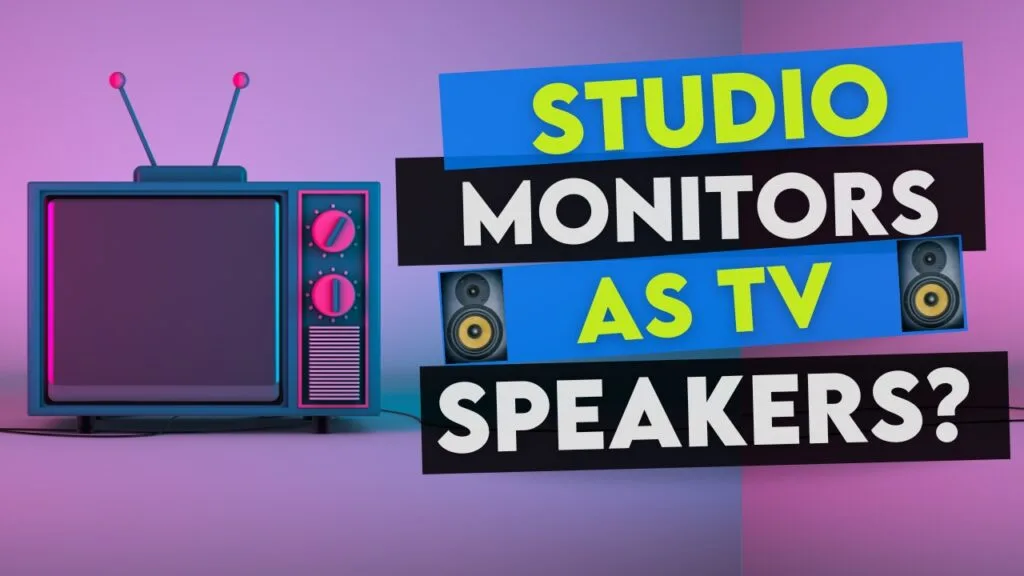
Can Studio Monitors Be Used As TV Speakers?
This depends on whether or not your TV has audio outputs that you can use to send the TV’s audio signal to an audio interface/directly to a pair of studio monitors.
For example, two of the TVs in my house have audio outputs. Still, one of the other cheaper TVs I use for an additional monitor in my home studio has no options for audio output.
If your TV has an audio output, you will likely be able to connect it to a studio monitor pair.
Should You Use Studio Monitors As TV Speakers?
No, it would be best if you did not use studio monitors as TV speakers unless you have to due to your TV’s speakers blowing out or something like this.
This is because not all speakers are equal and have different intended uses.
Remember, studio monitors, are for audio/music production and not other purposes such as TV speakers. Just because you can do it, it doesn’t mean you should.
How To Connect Studio Monitors To A TV
Let’s look at how you can connect studio monitor speakers to a TV if you wish to do so.
Step One – Find Your TVs Audio Outputs
The first step for connecting your TV to studio monitors is determining whether or not your TV has audio outputs and locating them.
To do this, look on your TV’s back or side and find its input/output section. Once you have found this, take note of your TV’s audio output options.
If you are unsure what you’re looking at, go online and find the owner’s manual for your TV. It will likely have a labeled diagram telling you the TV’s options for audio output.
Check out the three TVs in my house, and you will notice that…
The first one has options for optical as well as RCA audio output.
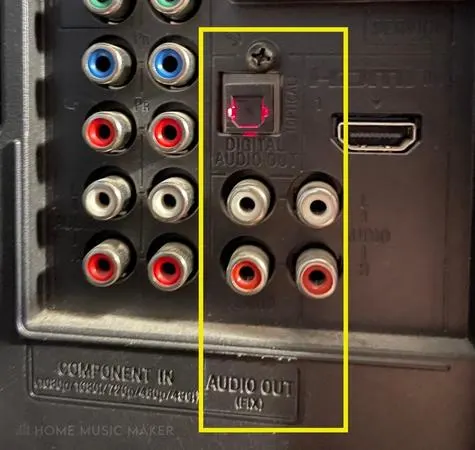
The second one has options for 3.5mm and RCA audio output.
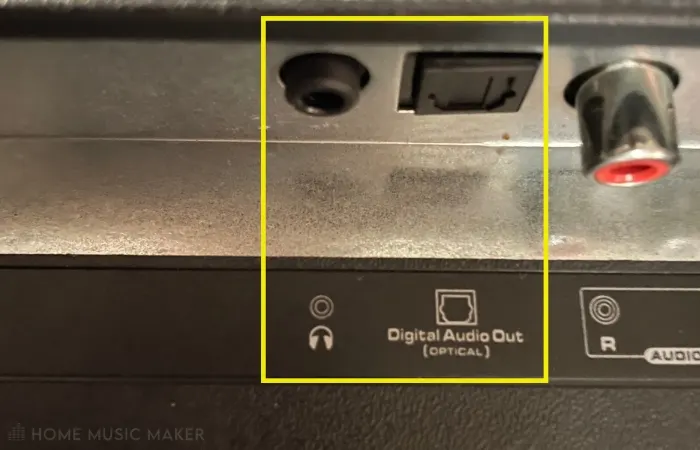
The third TV has no audio output options at all.
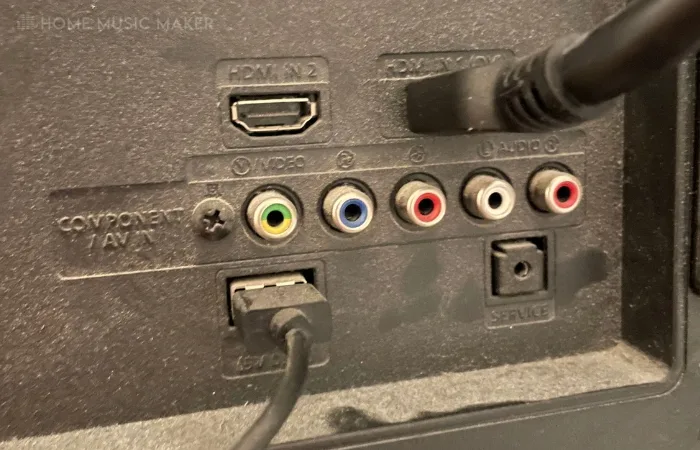
This shows that connecting studio monitors to your TV is a case-by-case issue, and you should pay attention to ensure you get the right cables.
Step Two – Find Your Studio Monitors/Audio Interface’s Inputs
Next, check out your studio monitors or audio interface and see their input options.
For example, my studio monitors have a combo jack input, which means they can accept ¼” TRS and XLR cable connections.
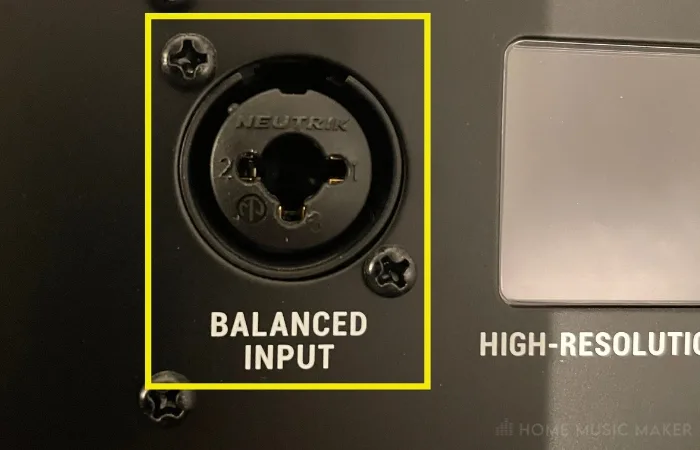
Again, refer to your owner’s manual if you need help figuring this out.
Now that we know our various connection options for our studio monitors and TV, we can move on and figure out how to connect them.
Step Three – Figure Out and Purchase The Required Cable
It’s time to determine what cable you need to connect your studio monitors to your TV.
For example, if you want to use your TV’s 3.5mm/AUX output port and connect it to the XLR inputs on your studio monitors, you could use a 3.5mm TRS to dual XLR cable.
Or you could use your TV’s RCA outputs and connect to your studio monitors’ ¼” inputs if you go with an RCA to dual 1/4″ TS cable.
What if your TV only has optical outputs? Then you might need to buy something like this that will allow you to turn your optical audio signal into an RCA/¼” audio signal. The other option would be to use your audio interface (if it has an optical audio input).
As long as your TV has audio outputs, there will be a way to connect your studio monitors to it. It’s a matter of finding the cables/any additional gear that you might need to get the job done.
READ NEXT:
Hungry for more knowledge? Check out this other article about connecting studio monitors to an audio interface.
Step Four – Connect Your TV To Your Studio Monitors and Adjust Levels As You See Fit
Now that you have the cables you need to connect your studio monitors to your TV, all that’s left is to wire them up. You can adjust the volume levels using your TV and studio monitors’ volume controls.
Once you find a good balance between the two volume controls, you are all done and ready to use your studio monitors as TV speakers!
Using Active Or Passive Speakers With A TV
You can use either active or passive monitors with a TV. Still, you will need a power amplifier with your studio monitors if you choose passive ones.
Whether you want to use active or passive speakers with your TV is up to you. Just remember you will need extra equipment if you use passive monitors.
Do You Need Additional Equipment To Connect Studio Monitors To A TV?
In most cases, cables are the only additional equipment you will need to connect your studio monitors to a TV.
However, as I’ve said, if you have passive studio monitors, you will also need a power amplifier to provide power to your studio monitor speakers.
In some cases, you may also need an audio converter device, but this depends on your specific case and probably isn’t something you need.
Do TV Monitors Have Speakers?
Suppose you buy a television monitor with a home studio or gaming setup. In that case, chances are it won’t have speakers because the manufacturer assumes that you will connect your own audio system.
However, this is sometimes the case, so research your needs before investing in a TV monitor. There are plenty of TV monitors on the market that do have speakers.
Also, suppose you are looking for a TV monitor with speakers. In that case, you can always invest in a regular consumer television for watching movies and television. There are better choices than this in some situations, but it can work in some cases.
Related Questions
Can KRK Rokit 5s Connect To A TV?
Whether or not you can connect your KRK Rokit 5s to your TV depends on your TV having applicable audio outputs.
If your TV has RCA or 3.5mm/AUX output ports, you can find a cable to connect your KRK Rokit 5s to your TV.
Why Would You Want To Use Studio Monitors As TV Speakers?
As far as sound quality goes, I don’t recommend using studio monitors as TV speakers, but here are some reasons that you might want to:
– The speaker set on your TV is not working, and you don’t have the funds to buy a new one, so you need to use external speakers that you have lying around.
– You like how your studio monitor speaker sets sound for TV playback.
– You want more low-end power than your TV speakers offer.
– You want to be able to place your monitor speakers around the room.
Although I do not recommend using a studio monitor speaker as a TV speaker, you can see some reasons to do so.
Can You Connect Headphones Directly To A TV?
If your TV has a 3.5mm/AUX output port, you can quickly and easily connect headphones directly to your TV.
This can come in handy if you want to watch a movie or television without disturbing anyone else in the house.
Do TVs Come With Quality Speakers?
The quality of the speakers in your TV will depend on the TV itself and how nice it is.
For example, buying a basic TV will have very basic and low-quality speakers.
However, if you invest in a higher-quality TV, it will also have higher-quality speakers.
Can You Use Computer Speakers As Studio Monitors?
The only case that I recommend using computer speakers as studio monitors is for total music production hobbyists. They should invest in a low-cost studio monitor pair before using computer speakers.
Computer speakers do not have the correct frequency profile for music production like studio monitors do.
Do You Need A Subwoofer In Your Studio?
A subwoofer can be a wise addition to your studio if you are serious about music production! Primarily if you produce music in bass-heavy genres.
However, the low-end response in a pair of studio monitors is sufficient for many music producers.
Final Words
As you have seen, you can use studio monitors as speakers if your TV has options for audio output.
However, although it is possible, I do not recommend it since studio monitor speakers are for audio/music production and not the playback of television audio.
Studio monitors do not necessarily have the right sound profile for use as TV speakers, so you should think twice about using them for this purpose.
READ NEXT:
Check out this other article that explores whether or not you should use KRK Rokit 5 studio monitor speakers for everyday music listening.=

 Want to connect with other music producers for help and guidance?
Want to connect with other music producers for help and guidance?
joe
Friday 21st of July 2023
First off I'm not music producer, just a fan of good clean sound. I read through this whole article looking for a reason not to use studio monitors. All you offer is they're not made for TV and they don't have the right sound profile. Can you explain why? I'm thinking about using studio monitors because they're the most accurate reproducers of sound. I hate to buy them and find out later why they sound horrible on a TV.
Matt
Sunday 23rd of July 2023
Hey Joe,
I hope I can elaborate some more.
Using studio monitors as TV speakers may not be the best idea, despite their reputation for accurate sound reproduction.
1. Sound Profile: Studio monitors are designed to provide a flat, neutral frequency response. This means they aim to reproduce audio as accurately as possible without adding any coloration or emphasis to specific frequencies. This characteristic is essential for music producers and audio engineers because it allows them to hear the recording as it truly is, without any alterations.
However, the sound profile of studio monitors may not be ideal for TV playback or general entertainment purposes. Consumer-grade speakers, including those in TVs, are often tuned to provide a more enjoyable and immersive listening experience. They may emphasize specific frequencies, such as bass or treble, to enhance movie sound effects and overall enjoyment.
Using studio monitors as TV speakers may result in a less engaging and somewhat flat audio experience, as they are not tailored to enhance the excitement and impact of movie soundtracks or TV shows.
2. Lack of Built-in Amplification and Processing: Most studio monitors are "active" speakers with built-in amplification. This design allows them to be connected directly to audio interfaces or mixing consoles used in music production. However, TVs typically do not output a high-level signal and don't have the necessary connections to directly power studio monitors.
You may need additional equipment like an external power amplifier or audio interface to use studio monitors with a TV. This extra complexity can make the setup less convenient and more expensive than dedicated TV speakers or soundbars.
3. Speaker Size and Placement: Studio monitors come in various sizes; some may be larger and heavier than typical consumer-grade TV speakers. Their size and weight might be less suitable for casual TV setups, especially if you have limited space or prefer a more streamlined appearance.
Additionally, studio monitors are often designed to be placed at ear level in an equilateral triangle configuration with the listener. This positioning optimizes the stereo image and soundstage for music production purposes. However, you might want a more relaxed setup for TV viewing where speakers can be positioned differently and still deliver a satisfying audio experience.
While studio monitors excel at accurate sound reproduction for critical listening and music production, TV speakers may have better choices due to their neutral sound profile, lack of built-in amplification for TV use, and potentially less practical form factor and placement requirements.
If you're a fan of good clean sound for TV viewing, there are many high-quality consumer-grade speakers, soundbars, or even audiophile-grade bookshelf speakers designed specifically for home entertainment. These options can provide an immersive and enjoyable listening experience without compromising on sound quality for your TV setup.
I hope that helps.
Cheers
Matt